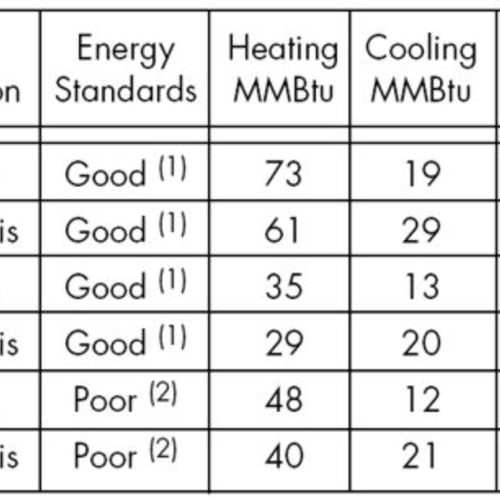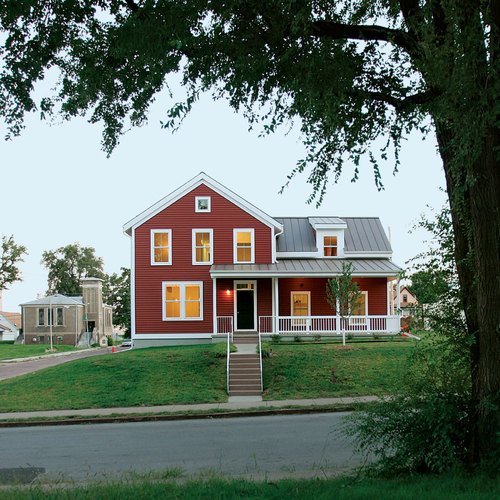Green is often less expensive when all things are considered
Sustainable building often seems more expensive than conventional building. Many of the building materials that make houses more durable and easier to heat and cool aren’t cheap. Complicated systems that allow a certain amount of energy independence–photovoltaic and solar hot water panels, for instance—can be very pricey. Common sense would tell most builders that it costs more to spray 8 inches of polyurethane foam in the roof than it would to install fiberglass batts.
But appearances can be deceiving. Take, for example, a decision to upgrade from double-pane to triple-pane windows. The windows will add thousands of dollars to construction costs. But they could eliminate the need for a warm-air register in front of each window, and the savings in labor and duct installation could offset the additional cost of the windows. In addition, the lower heating load means the size of the furnace can be downgraded. End result? Lower overall construction costs.
Savings can come in other ways. Spending more money for more durable materials is cheaper in the long run because they won’t have to be replaced as often. Considering life-cycle costs, rather than focusing solely on initial costs, can yield some surprising results.
Green building isn’t an all-or-nothing proposition. As long as the basics are there, the house can be upgraded over time. If solar panels are an intriguing long-term option but not in the cards right now, for instance, pre-plumb for the panels and install them when the budget allows.
Weekly Newsletter
Get building science and energy efficiency advice, plus special offers, in your inbox.









7 Comments
Building "Green" vs Traditional Article
The author makes several assumptions that may or may not be valid. Mathematical calculations must be made to determine the practicality of downsizing the size of the heating plant when triple- vs double-paned windows are used. The increased costs in going green must have a reasonable chance of being recovered by the builder via a higher sale price for the house. This is pretty dicey in the current, depressed real estate economy, especially when every buyer is looking at comparable and equivalent homes when making a buy/no buy decision. Recovery of energy-efficient investments in a home such as a photovoltaic systems can take 8 to 11 years. When people move on the average every 6 to 8 years, buyers may not see the advantage to making such an expenditure. And the assumption that "spending more money for more durable materials is cheaper in the long run because they won't have to be replaced as often" is a statement that is overly simplistic and lacking validation. My comments notwithstanding, I believe green is the only way to go. But in order to generate broad buyer support, builders should think about using technology that has been scientifically proven for universal applications in home building - 2 by 6 exterior framing, exterior insulation boards, low-flow plumbing technology, etc, - and to use elective, emerging and higher-end technology customized to specific buyers with whom they contract. Keep up the great work in your articles - they're always informative and thought-provoking.
Regards,
Kevin Thompson
Sinus Rhythm Real Estate Development Corporation
Sinus Rhythm Home Inspection Service
165 Asharoken Ave
Northport, NY 11768-1166
631.262.0142
516.458.1577
[email protected]
NYS LIcensed Home Inspector #16000017901
NYS Licensed Home Inspection Field Instructor
NYS Licensed Real Estate Agent #40TH1117460
NYS LIcensed Real Estate Instructor
NYS Certified Fire Safety & Building Code Enforcement Officer #0709-7275
Suffolk County, NY Home Improvement Contractor License #45727H
I am curious as to why 8" of
I am curious as to why 8" of closed cell urethane foam would be needed. At 2" this foam is a vapor barrier and also a thermal break and since most heat loss occurs in bypass leaks in the exterior energy envelope 8" is overkill. 1-2" of foam with blown-in on top is adequate for the attic.
Also, the author should have
Also, the author should have done some research. Downgrading the heating plant and duct work has no serious impact on offseting the cost increase of triple pane windows. Wow, sit down and call a building supply house or better yet, go build a house with your own money and then write the article. Finally, more attention should be paid to building green affordable housing. There is a contradictory statement.
Response to Anonymous
Anonymous,
1. There are at least two types of spray polyurethane foam. Eight inches of open-cell spray foam has an R-value of about R-30 -- which is less than the minimum code requirement in northern states. Eight inches of closed-cell spray foam has an R-value of about R-52, which would be consistent with a well-insulated home in a cold climate.
You're right that other methods of insulation would be less expensive to install.
2. I agree with you that for most new homes, the savings associated with a smaller furnace and shorter ductwork runs won't be enough to pay for the upgrade from double-glazed to triple-glazed windows.
However, in very cold climates, triple-glazed windows provide comfort benefits as well as long-term energy savings, and these factors may tip the balance in favor of triple glazing.
photovoltaic
I dislike the word "may" in an article that is supposed to give me facts. Speculations are exactly that, "speculations." I think and want to build as well as I can afford, but some things will never make economic sense. I believe in passive solar, high thermal mass, and superinsulated homes, but for adequate electric photovoltaics have a long way to go. Rather than taking 11 years to pay back they do not payback. Remember they have a "shelf life" and need to be replaced also. The cost for the energy generated is way too high. The only place I see for them is when people have the money to "make a statement" or when being on the grid is not possible. We do much better by looking for energy efficient appliances. I put in triple pane windows in place of double pane. The improvement was insignificant for either energy savings or comfort. Next time I will probably go double pane with internal stormwindows and better movable insulation. The cost would be less and the comfort greater. Obviously I favor green, but we shouldn't pretend that all our dreams will be cost effective
Response to Chris M
Chris,
I'm not the author of the article on this page. My own take: quality construction (and that's what green building is) costs more than sloppy construction. It always has, and it always will.
Of course triple-glazed windows cost more than double-glazed windows.
Of course it costs money to pay attention to airtightness (instead of building a leaky building).
Of course including a PV array on the roof costs more than not including a PV array.
Of course above-average insulation levels cost more than code-minimum insulation levels.
Green builders can save money by building small and being happy with a simple home without many bells and whistles.
4 yrs later, any changes in the cost premium of going "green"?
I'm finding that unless you're doing a gut/rehab the luxury builders ($1MM and up) are still the only ones who really go the extra mile. Tract building (An overwhelming majority of homes built in Atlanta is tract housing) seems to be stuck with the code-minimum.
I only mention this because we're trying to build a tract size house, but we're encountering luxury builder prices.
Log in or create an account to post a comment.
Sign up Log in